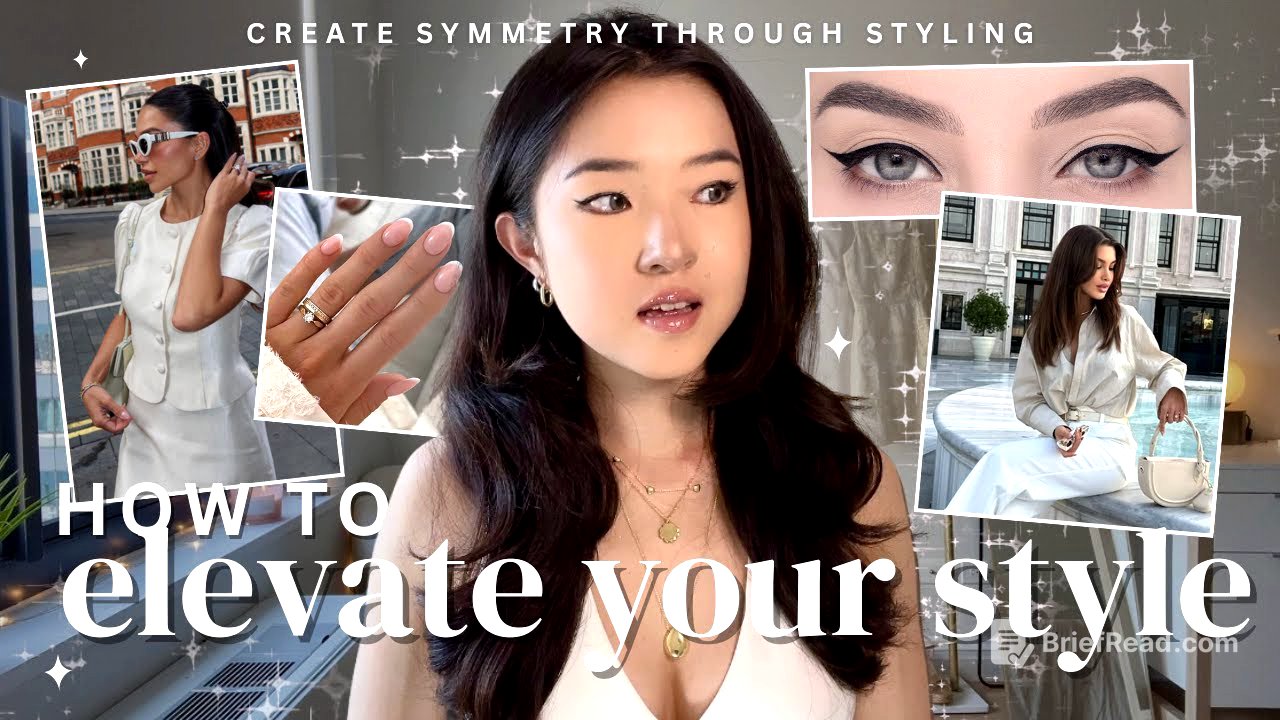TLDR;
This video discusses how to use visual symmetry to enhance personal style by balancing proportions and features. It covers clothing choices for different body types, the use of color to create balance, the impact of structured vs. unstructured clothing, and how to use hairstyles and makeup to address facial asymmetry.
- Balancing proportions is key to visual symmetry.
- Color and structure in clothing can enhance symmetry.
- Hairstyle and makeup can address facial asymmetry.
Introduction to Visual Symmetry [0:00]
The video introduces the concept of visual symmetry as a tool to enhance personal style by balancing proportions and features. It emphasizes that asymmetry is normal and that the goal is not to achieve perfect symmetry, which can appear unnatural, but rather to use styling techniques to create visual balance and harmony. The focus is on using styling as a tool to enhance one's features and ensure that the outfit complements the wearer.
Clothing Choices for Different Body Types [1:06]
The video explains how to dress for different body types to achieve visual balance. For those with a wider upper half (inverted triangle or athletic body type), it suggests wearing wider bottoms like pleated skirts or wide-leg pants to add bulk to the lower body and balance the proportions. It recommends avoiding tighter bottoms like pencil skirts and opting for tighter tops with narrow necklines to minimize the upper body. For those with a wider lower half (pear shape), it advises choosing sleek bottoms and adding volume to the upper body with puffy sleeves and wide necklines. Those with naturally balanced proportions (hourglass or rectangle) can generally wear styles from both types, with rectangular figures benefiting from flowy styles and wider bottoms to add curves. The general rule is to use form-fitting styles to set back an area and voluminous styles to enlarge it.
Membership Program Announcement [3:19]
Julianna announces the launch of her membership program on her website, style-elev.com, designed to build a close-knit style community. The program offers multiple tiers with no commitment, featuring style videos, blog posts, digital lookbooks, guides, celebrity analyses, and giveaways. Everyone who signs up in the first week will be automatically entered into the first giveaway.
Using Color to Create Symmetry [4:11]
The video discusses how color can be used to create symmetry in outfits. Dark colors and matte finishes minimize areas visually, while lighter colors and shiny finishes expand them. It suggests using darker colors for larger features and lighter colors or bright patterns for smaller features to create harmony. The "sandwich method," which involves matching the color of the top and bottom of the outfit (e.g., top and shoes or shoes and hair), is presented as a technique to make an outfit look complete and balanced. Adding a pop of color evenly throughout the outfit can make it look more elevated.
Structure in Clothing and Facial Asymmetry [6:38]
The video explains that more structured styles tend to look more symmetrical and visually pleasing due to their cleaner lines. Structured clothing is more flattering because it is looser and not skin-tight, making the wearer more photogenic. For facial asymmetry, it suggests using the hair part to offset it, positioning the larger half of the hair on the smaller side of the face. A middle part can highlight facial asymmetry, making it best for symmetrical faces.
Hairstyles for Different Face Shapes [7:40]
The video provides hairstyle recommendations based on face shape. For those with a wider forehead and narrow chin (heart-shaped face), styles with volume at the ends of the hair are recommended to pull focus down and add volume to the chin. For those with a shorter forehead, half-up, half-down styles or high updos are suggested to add focus to the forehead. Longer faces benefit from shorter, wider hairstyles, while shorter or rounder faces look balanced with longer, flatter hairstyles.
Makeup Techniques for Symmetry [8:33]
The video shares makeup tips for enhancing symmetry. If either the upper or lower lip is thinner, using a matte nude liner to overline slightly or adding a blended shadow outline can make the lip appear fuller. Drawing symmetrical wings can visually take over and increase facial harmony, even if the eyes are not perfectly symmetrical.









